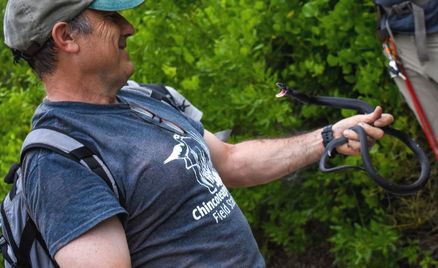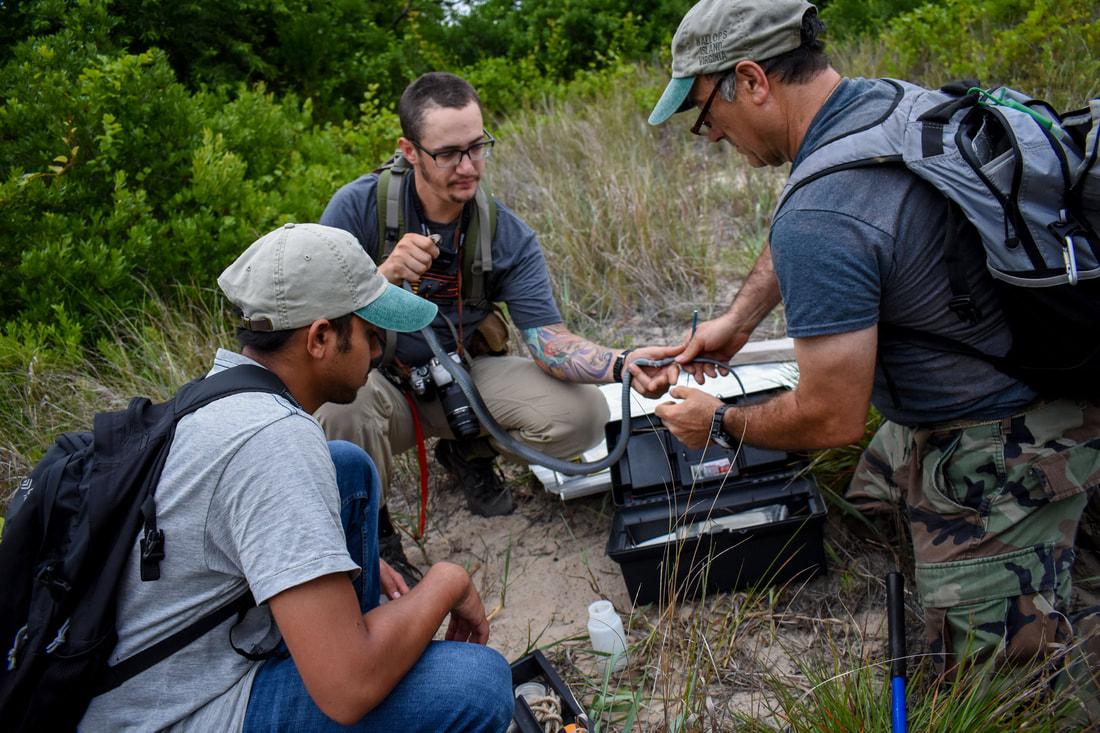 Coastal Herpetology students at the field station last session spent a part of their three weeks on NASA’s restricted flight facility searching for snakes to tag and study. Coluber Constrictor, or Black Racer, is a common species of snake found throughout the eastern United States. These snakes are generally black, between three and five feet long, and as their name implies, very fast. Not to worry though, racers are not venomous and will usually flee from humans. However, in dire circumstances, these snakes are not afraid to bite. Just ask Dr. Pablo Delis, the coastal herpetology professor here at the field station. Many Black Racers sank their teeth into Delis as him and his students conducted research on this snake’s population on Wallops Island. The class aimed to measure the snakes, determine their level of health, and tag them. But getting snakes to cooperate with research is no easy task, let alone actually capturing them to get those measurements. Black Racers hunt via sight, meaning they are active during the day and hide in burrows, bushes, or underneath debris during nighttime and cooler weather. So in order to conduct their research, the students set up metal boards throughout the Wallops Island dunes, providing potential shelter for the snakes. Returning to the dunes at dusk, when snakes were likely to be seeking shelter, the students visited each of the boards again to check for Racers. To catch the snakes the students surrounded the board and flipped it suddenly. This allowed Delis a few seconds to grab the surprised snake with his bare hands, hence the bites. The snakes have reason to bite though. Many of the individuals had damaged scales, scratches, and missing tails, among other injuries inflicted by the predators of Wallops Island. According to Delis, the main predators of the black racers are birds, raccoons, and other snakes. Besides their bite, the Racers also possess another defense mechanism in their tail. Delis said that when in grass, this shaking makes a sound similar to that of a rattlesnake’s tail in hopes of warding off hungry predators. After tagging, taking measurements, and noting which board the specimen was found under, the students would release it back underneath the board in hopes the snake would continue to use it as shelter, allowing for future observation. After checking all of the boards, the students decided to use the last few minutes of remaining daylight to check underneath other pieces of debris in the field. Kutztown University student Michayla took advantage of the opportunity and grabbed a large Racer from underneath a piece of driftwood. It was an impressive catch, but it was not without injury, Michayla mentioning that she couldn’t wait to tell her mom she was bit by a snake. While many might not enjoy an evening of chasing snakes, this class had a great time in the field, especially Delis. “Who needs a gym membership when you have Herpetology? You can’t beat running around to catch things that wriggle.”
1 Comment
7/14/2017 03:56:03 pm
Friends at the CBFS.
Reply
Leave a Reply. |
About
Everything you need to know about CBFS's educational programs, visiting Chincoteague Island, and more! Categories
All
Archives
January 2019
|
CHINCOTEAGUE BAY FIELD STATION | 34001 Mill Dam Road | Wallops Island, VA 23337 | (757) 824-5636 | [email protected]

 RSS Feed
RSS Feed

